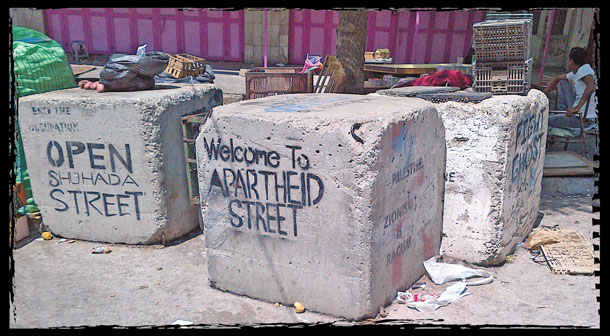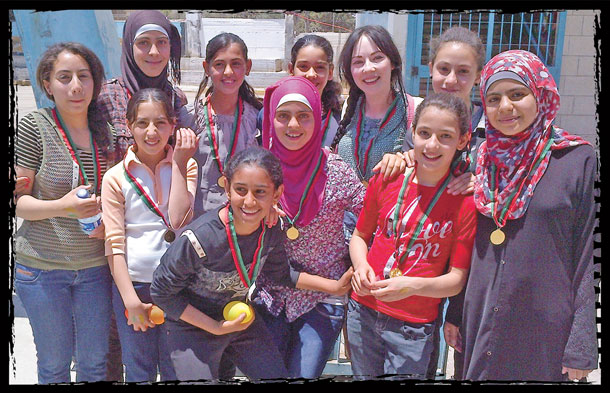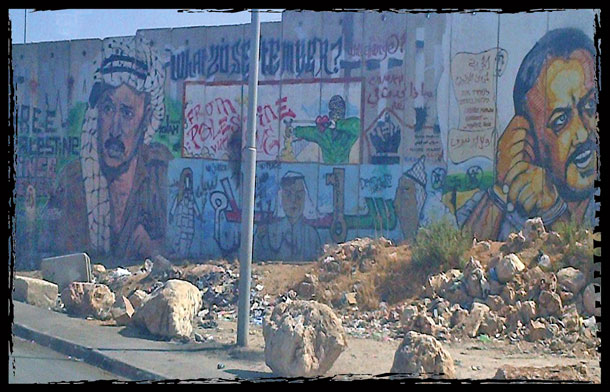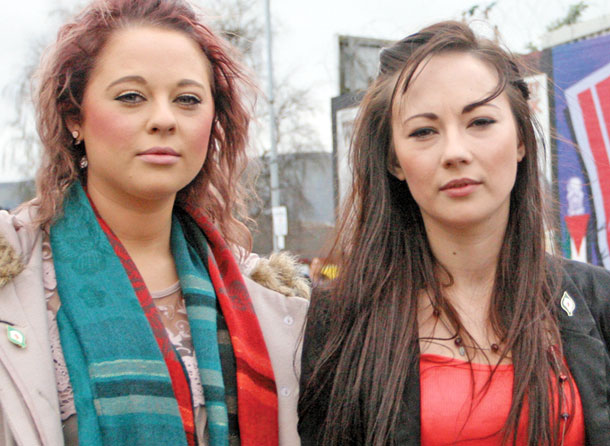2 September 2012 Edition
Eyewitnesses in the West Bank
Sinn Féin activists sisters Mary Kate and Mairead Quinn Return from Palestine

• Shuhada Street in Ramallah blocked by Israelis
‘The [Israeli] settlement looked great: new roads, spotlessly clean . . . in the Jalazone camp, with its population of 14,000, the first thing that hit me was the smell of urine — the Israelis control the water’
IN JUNE of this year, two young Sinn Féin activists, sisters Mary Kate and Mairead Quinn, travelled to the West Bank with the education charity UNIPAL to work with Palestinian children and teach English.
Before their departure they talked to An Phoblacht’s PEADAR WHELAN about their hopes and fears for their six-week stay in a country under unrelenting Zionist occupation and military control.
Now back in Belfast, Mary Kate spoke again to An Phoblacht, recounting her experiences in the Jalazone refugee camp near Ramallah.
ARRIVING IN TEL AVIV, Mary Kate expected to be put through an intense customs/security process, given the suspicion the Israelis have of foreigners and historical experience. However, she was relieved that she was held and questioned for ‘only’ 10 minutes.
“We stayed in Jerusalem for two days before heading to Ramallah. The bus journey was an eye opener. We drove along the ‘Security Wall’ — also known as the ‘Apartheid Wall’ — for ages before going through the checkpoint.
“It was like going from one world to the next, everything turned dirty, derelict and shabby. Rubbish everywhere — literally. It was as if it was being used as a dumping ground to keep Jerusalem clean and attractive.”
From Ramallah she went to the Jalazone camp.
The camp is on the left of the main road while on the right the massive Ma’ale Adumim Zionist settlement dominates the countryside.
“The settlement looked great: new roads, spotlessly clean, new homes with fencing and wire surrounding the entire settlement. And with a further 300 new homes to be built under the direction of the Israeli Government it will continue to expand and dwarf the Jalazone camp with its population of 14,000. The roads are tiny and the houses and flats are built so close together.
“The first thing that hit me was the smell of urine but I came to realise that the intensity of the smell comes and goes. It depends on the water the camp has. The Israelis control the water and Jalazone camp only gets its tanks filled every two weeks.”
When Newry gained city status in December 2011, it was reckoned to have a population of 27,434. Ma’ale Adumim became a city in 1991 and is home to over 30,000 settlers. Palestinians believe the Zionist plan for Ma’ale Adumim is to ensure an outer ring of Israeli settlements that will have the effect of isolating East Jerusalem from Jericho and eventually the north West Bank from the south.

• Mary Kate with some of the students from her class
Israelis use the term ‘settlement’ to give the impression of a small number of people with a light presence in an area, but this is so far from the truth. One settlement, Beit El, near the refugee camp Mary Kate stayed in, was recently in the media. Israelis living illegally in five houses built on private Palestinian land were brought to court but struck a deal with the Israeli Government and vacated the houses so that 10 apartment blocks, totaling 300 homes, can be built there instead. Yariv Oppenheimer, executive director of Peace Now, told the Jerusalem Post that the expansion plan rewarded the settlers. “They broke the law and now they are getting more space from the Government,” he said. He added that expanding the boundary line of a settlement also flew in the face of Israeli pledges to the international community not to take more land for West Bank settlements.
Mary Kate Quinn agrees and adds:
“The definition of ethnic cleansing is ‘the systematic elimination of an ethnic group or groups from a region or society by deportation, forced emigration or genocide’. These settlements are cities: huge places built on stolen land and surrounded by the Israeli Defence Forces (IDF).”
For Mary Kate the oppressive presence of the Zionist settlement was overbearing and the threat from the IDF was ever-present.
In fact, on the night she arrived in Jalazone, the Israeli Army carried out a raid on the camp.
Ten people were arrested and taken away. During the incursion, Israeli troops fired plastic bullets and tear gas.
Nor were the effects of occupation ever far away in everyday life for Palestinian people.
“I was very concerned about one of the girls in my class. Her uncle is imprisoned and I think it is affecting her deeply.”
According to people in the camp, Israeli settlers have opened fire on children from the school when they have climbed out to retrieve a football.
She went on to say that, since the year 2000, the Israeli Army has killed 1,471 children in the West Bank and in Gaza: the bulk of them were between the ages of 13 and 17 years old.

• A section of the Apartheid Wall near Jalazone
During the time Mary Kate spent in Jalazone, teaching and working with the children, she came to discover that, despite military repression and the grinding poverty that dominated their lives, the Palestinian children were very spirited.
“They were amazing. They were so willing to learn and really enjoyed the classes. They were also very grateful for what we were doing for them.
“In the time I was in the camp I got to meet a lot of people, mostly women, and I found them to be very strong and determined.”
Mary Kate found that social relations between men and women are very patriarchal.
“It really was such a culture shock to see that society is still divided with the women being very much in the home cooking, cleaning and caring for the children. And what really shocked me was that a lot of these women had university degrees yet their main responsibilities was to stay in the home as homemaker.”
When she was teaching, Mary Kate had to teach the boys separately from the girls.
“I’ll never forget the kindness of the people, especially the women. They would invite us around to their homes for meals and we’d just sit talking and getting to know each other.
“On our last night we were having dinner with one of the younger women that we met when her older neighbour came in.
“She asked us over to her house to show us her garden with its allotment where she grew vegetables. She had these wonderful paintings as well and she was so proud of her house.”
But the message for Mary Kate was that this wasn’t the woman’s home — she was living in a camp as a refugee because the Israelis had driven her, her family and many more Palestinians out of their real homes and they will never be happy until they have returned.

• Mairead and Mary Kate Quinn
Tension on the road to Cairo
MARY KATE and her sister, Mairead, were returning to Ireland through Egypt, flying out from Cairo.
The upheaval of the ‘Arab Spring’, the tension between Egypt’s newly-elected Muslim Brotherhood president and Egyptian Army generals, added to the heightened fears along the border with Israel, meant there was a heavy military presence in the Sinai Desert.
The Sinn Féin activists’ bus journey across Sinai took 10 hours.
“I began the long journey to find it being prolonged due to checkpoints; not just by the Egyptian Army but also by those caught up in the recent revolution.
“About an hour into the journey, we were stopped and surrounded by men in plainclothes and armed. It was all quite surreal and happened quite quickly. They pulled the doors of the vehicle open while others opened the boot and went through our belongings.
“They were shouting at us for our passports. We handed them over. All the while, the men were staring at us. A few girls had their hair quite loose and had their arms on show so, being an Arab country, this was seen as quite provocative.
“They talked amongst each other while two men brought the driver into a hut. At this stage we were completely clueless as to what was going on or what was going to happen.”
Eventually, the men (Mary Kate never found out who they were) told them they were not allowed through.
“It was quite nerve wracking as I had no idea where we were or where we would end up.”
They drove two hours south to a place called Taba where they got a minibus to take them to Cairo.
Mary Kate recounted how they drove through the desert for an hour and drove into an Egyptian Army checkpoint.
They again requested their passports.
“The Army held us for 30 minutes or so then announced they would be giving us an escort due to the possible danger of being kidnapped.
“They were wary of this as we were ‘Westerners’ and if anything happened there would be an international outcry. The soldiers rotated throughout the escort, which lasted around five hours of our journey. I was never as glad to see a place as I was to see Cairo.”




